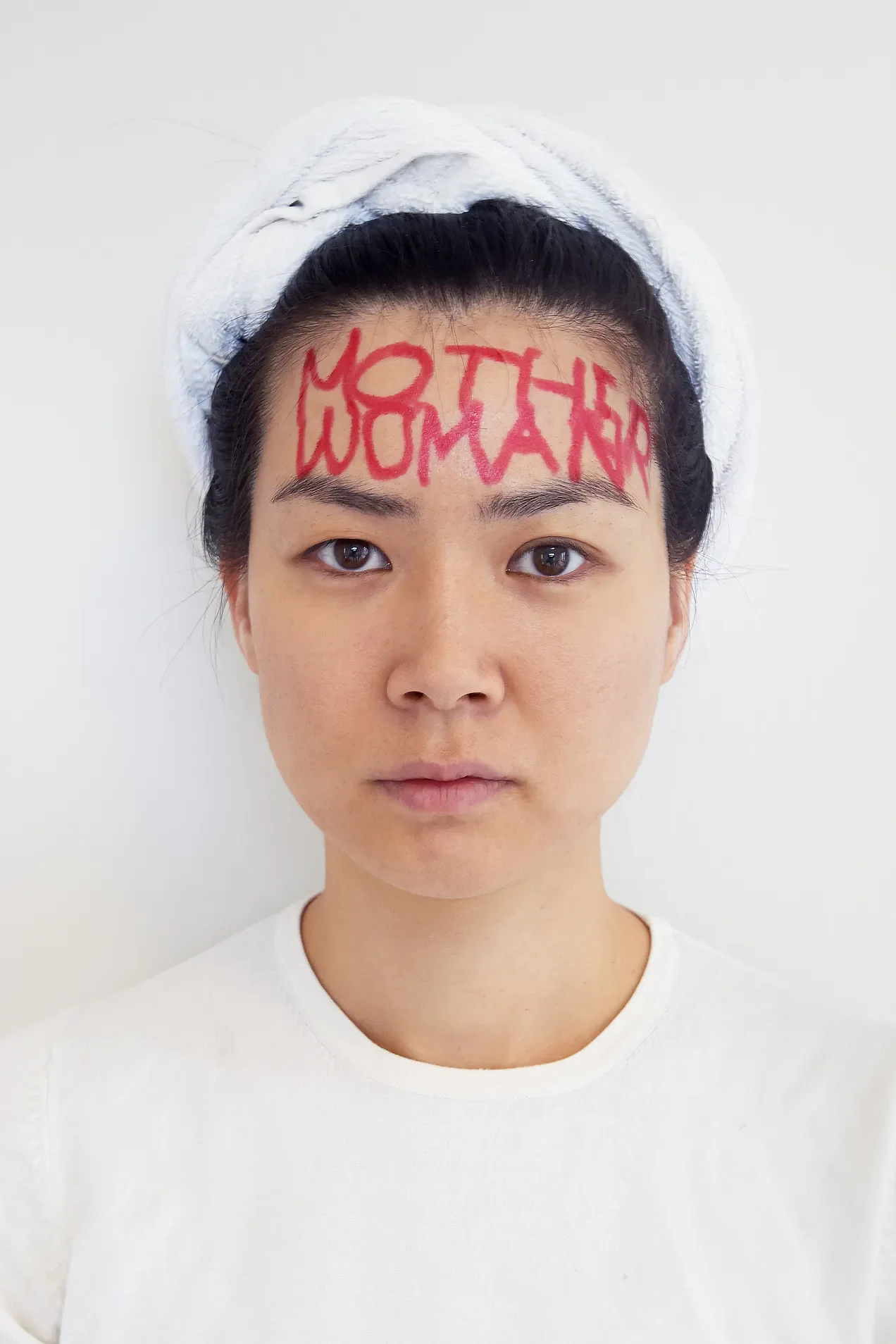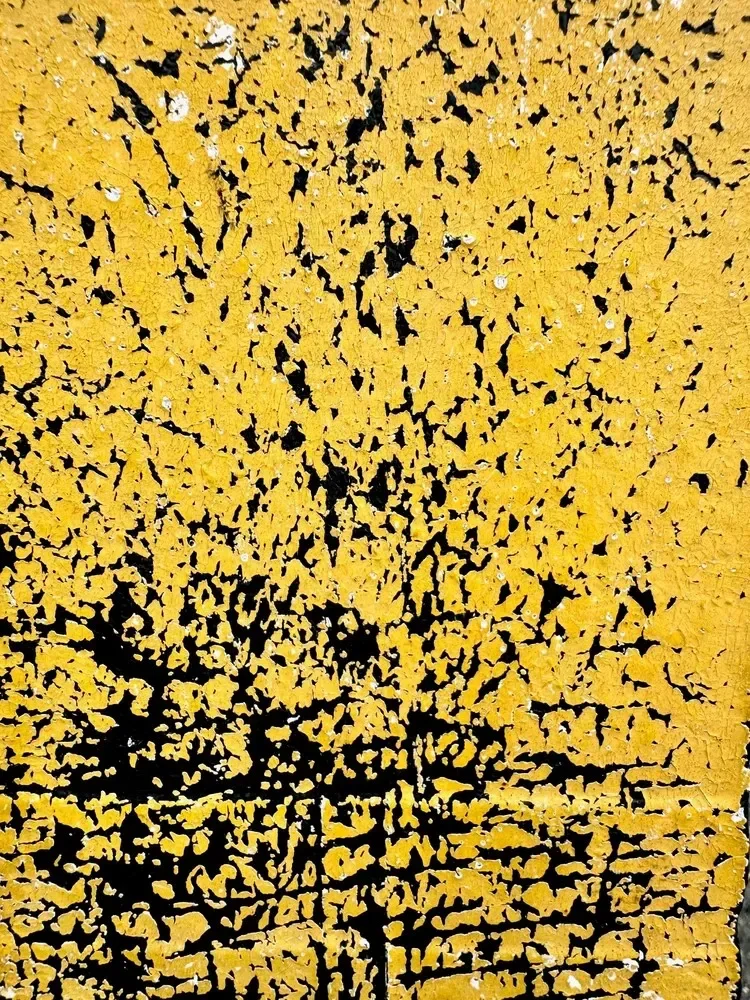“The Written Woman
Words mark bodies in a show of Korean women’s art. Also: two more installments of “Women Artists of the DMV”; duo shows of Joanne Kent & Richard Tinkler; & Deb Furey & Gordana Geršković
Yoon Jeongmee, “Red Face” (Trio & Beats Curatorial Collective)
OCT 27, 2025
A KEY WORK IN THE CURRENT THREE-VENUE SHOWCASE of Korean and Korean-American women artists is Hong Lee Hyunsook’s video, “Menopause 1 & 2,” in which a woman at a public bath writes an auspicious message on another woman’s back. But inscribing text on female flesh is just one of four themes of “Ecriture with the Body: Contemporary Korean Women Artists,” an ambitious exhibition at IA&A at Hillyer, the Korean Cultural Center, and the Corcoran School of the Arts and Design at the George Washington University.
The 18-artist array, which was curated by Dr. Jung-Sil Lee and Dr. Koh Dong-Yeon, also has three other motifs: challenges to traditional literati painting, Korean women’s poetry, and the legacy of Theresa Hak Kyung Cha. In addition, many of the pieces reflect on aspects of women’s reproductive biology -- miscarriage, pregnancy, and mothering as well as menopause.
The exhibition is haunted by the presence -- and absence -- of Cha, a Busan-born writer, filmmaker, and performance artist who emigrated to the U.S. at 12 and who was raped and murdered in New York City at 31. Several contributors employ excerpts from Cha’s Dictée, a posthumous poetic novel that’s one of the threads connecting the diverse work in this selection of art that’s mostly conceptual and often takes the form of photos and videos.
Thus Jean Jinho Kim, a D.C.-area artist known for sleek aluminum sculptures, enters the spirit of the show by incorporating Cha’s text into her customarily wordless work. At the Corcoran, two pieces in mirrored negative and positive forms are linked by text. At IA&A, a trio of Kim’s fabrications, leg-like forms with booted feet, have lines from Dictée projected behind them.
The words are written in lipstick in the video and photos, at the Korean Cultural Center, of Yoon Jeongmee’s performance, “Red Face.” She covers herself with such defining labels as “mother” and “woman” until her flesh is almost entirely scarlet. Seongmin Ahn renders blunt English phrases, hostile and often profane, in a traditional Korean style of elaborately ornamental script; her sardonically flowery placards are at the Corcoran and the Korean Cultural Center. At the latter are photos of a Cha performance in which she covered her face in fabric strips that read “voix aveugele,” French for “blind voice.” (Ironically, “voix” blocked her eyes and “aveugele” her mouth.)
Blindness also serves as a metaphor in the work of one of the D.C.-area participants, Hyun Jung Kim, who makes metal crowns and finger and toe covers embellished with patterns in Braille. These objects, on exhibit at IA&A and the Corcoran, are used in performances and audience-participation selfies and refer to what Kim calls the “cultural blindness” she experienced upon moving to the U.S.
Korean text adorns Minsun Oh Mun’s playfully update of a Joseon Dynasty landscape painting. In the picture, at the Corcoran, lurking monks use cellphones to photograph women who are bathing in a stream. Also at the Corcoran are Jean Shin’s wall sculptures made of computer keyboard keys, grouped into repeated readings of such multiple-meaning words as “home” and “enter.” Jung Jungyeob’s paintings and assemblages often feature Korean words spelled out in red beans. The beans represent women’s labor in Jungyeob’s work, at IA&A and the Corcoran.
American viewers may not understand the significance of some references, notably the Jeju Island palm trees photographed by Kim Oksun (KCC); the semi-traditional, semi-farcical sun-worship ritual staged for video by Yeesookyung (Corcoran); or the gloomy old ballad (helpfully subtitled) that plays in Jaye Rhee’s video (KCC). But East can meet West evocatively, as in Kim Jipyeong’s tribute to difficult women, “Rebecca, Bertha, Carmilla, Audley” (Corcoran). Named after troubled heroines of 19th and 20th century English-language novels, the piece consists of four damaged hanging scrolls that the artist likens to female bodies. The words here are less important than the scrolls themselves, precarious yet enduring.
Joyce Zipperer, “Hell on Wheels” (photo by Mark Jenkins)
SOME OF THE AREA’S BEST-KNOWN WOMEN ARTISTS are among the nearly 75 included in exhibitions at the Athenaeum and Pyramid Atlantic Art Center. Both shows are, of course, installments of “Women Artists of the DMV,” the 18-venue extravaganza arranged by curator Florencio Lennox (Lenny) Campello. The Pyramid selection is more diverse in media and slightly bigger than the Athenaeum one. It’s also more political.
Stars and barbed wire, both made of glass, overlay a U.S. flag in Trish Kent’s “The Divided States of America,” a suitably prickly statement for immigrant rights. An eloquent memorial for a victim of police violence, Janathel Shaw’s “Grief for Philandro Castile” is a stoneware bust of a male angel with Castile’s head embedded in his chest, framed by two bullet shells. Also fashioned deftly of ceramic and metal, Jennifer Hayes’s “Armor Eaters” is a set of women’s underwear being eaten by cast-bronze moths who represent the undermining of women’s autonomy. Amity Chan, a Hong Kong native, protests the crackdown on dissent in her homeland with a high-contrast rendering of a set of handcuffs in red and yellow, the colors of the Chinese flag.
Pyramid usually exhibits prints and other works on paper, a category that encompasses some of the most striking pieces in this show. Courtney Applequist’s “So You Say” is a self-described “doodled self-portrait” stretched across 60 pages from a right-wing Christian book the artist terms misogynistic. Katherine Tzu-Lan Mann’s partly abstract collage-painting fits her trademark swirling elements into an uncharacteristically tidy rectangle. Among the traditional realist prints are two that are intriguingly dark and shadowy: Ellen Verdon Winkler’s mezzotint of a gabled house and Jenny Freestone’s meditative etching-engraving of a bird’s disembodied head.
Some of the three-dimensional entries play with formats that are customarily flat. Joan Konkel’s “Bent Out of Shape” in a purple-and-black hanging banner made of canvas that’s slit into bands and woven. Margaret Boozer’s ceramic relief map is made partly from soil from her yard in nearby Brentwood. Also ceramic, Catherine Satterlee’s “Scully Square vii” is a color field painting rendered with stoneware in shades of bronze. More fully sculptural is Joyce Zipperer’s playful “Hell on Wheels,” a metallic mashup of high-heel and rollerblade. Placed across from Hayes’s “Armor Eaters,” it’s an aptly mobile symbol of female autonomy.
The Athenaeum array is heavy on abstract and near-abstract paintings, many of them with a liquid quality. Anne Marchand’s exuberant “Mirabilia” is a mixed-media montage that features thick pigment, fluid pours, and stubbled textures. Sparked by an aerial view of a salt bath, Anne Cherubim’s immersive “Inspired by Salt II” depicts a series of turquoise pools separated by undulating bands of metallic silver. Suzanne Yurdin’s luminous “Upwelling” is a mostly blue, seemingly aquatic scene with sunlit white highlights; it complements Susan Shalowitz’s dynamic “Sonata,” a detailed realistic painting of surf.
Somewhat more linear is Carol Brown Goldberg’s elegant “2:00 p.m. at Hanlon Park,” whose gridded dots fade from blue to white atop a field of splashed, dripped colors with touches of glitter. The picture’s backdrop is akin to the heavily worked surface of Cianne Fragione’s “Workers Wearing Toe Shoes,” a collage-painting that suggests strata of history. The rough layers of these compositions are very different from the overlapping color blocks of Adi Segal’s “8 Block Quilt Variation,” whose translucent forms are deployed high above the gallery on a horizontal window.
The representational works include pictures by Anna U. Davis and Helen Zughaib in their familiar stylized modes. Both depict women, but where the former’s “Crying Girl” renders isolation in shades of black and gray, the latter’s “The Long Wait” portrays a queue of closely grouped women whose presence is defined entirely by their colorfully patterned robes. The first seems stuck and the others are on the move, but each circumstance is equally urgent.
Joanna Kent, “Speechless” (PFA Gallery)
BRUSHSTROKES ARE ARCHITECTURAL OR EPHEMERAL, respectively, in the work of Joanna Kent and Richard Tinkler. The two artists, showing together in PFA Gallery’s “Vibrations,” both use oil paint to make vivid abstractions. Kent’s sculptural paintings cover cubes or vertical panels with dried plumes of a heathered single hue. Tinkler’s multi-color pictures appear to be blurred, but close inspection reveals the illusion of softness is created by thousands of tightly fitted small gestures.
Kent is a veteran D.C. artist who melds sculpture and painting somewhat in the manner of Anne Truitt, but Kent’s work is as craggy as Truitt’s is sleek. The 11 pieces in this show, made between 1998 and 2002, cover flat surfaces with tufts of pigment, so that the blocky ones resemble carefully pruned shrubs. The wall-mounted vertical panels are bisected by narrow gaps in the paint, a breach that’s most conspicuous in the all-black “Eclipse.” These subtly drawn lines offer the eye a passage into the object, but then the artist’s creations are riddled with small inlets. That Kent’s 3D paintings appear simultaneously solid and airy is their essential mystery.
Where Kent retains something of the fluidity of pigment, Tinkler relies on its liquid qualities. He applies layers of paint while the lower level is still wet, so that different colors partly meld into each other. The resulting images are soft yet organized into overall patterns such as multiple diamonds or rows of lozenges. These paintings, from 2024-25, are fundamentally orderly. Yet they have an oasis-like shimmer that suggests that at any second they could transmute, or even vanish altogether.
Gordana Geršković, “ Jiyūgaoka” (Foundry Gallery)
THE TWO ARTISTS OF “AFTERTIME” STRETCH A BIT in this Foundry Gallery show, but the best work is in familiar modes: Deb Furey’s bold charcoal drawings of costumed people, and Gordana Geršković’s photographs of battered walls and other surfaces, rendered in closeup so they appear abstract.
To these, Furey adds some brightly hued paintings that portray her usual subjects in looser forms, while Geršković emulates her own small photos with a larger mixed-media painting of what appears to be a grainy, pitted surface. None of these are highlights of the show.
Instead, viewers are likely to be drawn to Furey’s pictures of kings, queens, jesters, and mythic trans-species creatures, all packed into crowded, dynamic compositions. Sometimes interrupted by insets or overlaid with primary colors, these drawings evoke the roles we all play, or wish we could assume.
While impossible to place in their original contexts, Geršković’s images work as pure patterns and sometimes as accidentally representational shapes. The artist titles a few of her pictures after places, presumably where the photo was made, although knowing that Jiyūgaoka is an upscale Tokyo neighborhood doesn’t help in identifying the field of black cracks on gold as part of recognizable location. Where Furey’s symbolic scenarios have a universal quality, Geršković’s photos are highly individualistic: She reveals tiny aspects of reality that no one else might have seen.
Ecriture with the Body: Contemporary Korean Women Artists
Through Nov. 2 at IA&A at Hillyer, 9 Hillyer Court NW. athillyer.org. 202-338-0680; and Nov. 12 at the Korean Cultural Center, 2370 Massachusetts Ave. NW. washingtondc.korean-culture.org/en. 202-939-5688; and Nov. 15 at the Corcoran School of the Arts and Design at the George Washington University, 500 17th St. NW. corcoran.gwu.edu/corcoran-exhibitions
Women Artists of the DMV
Through Nov. 2 at the Athenaeum, 201 Prince St., Alexandria. nvfaa.org. 703-548-0035; and Pyramid Atlantic Art Center, 4318 Gallatin St., Hyattsville. pyramidatlanticartcenter.org. 301-608-9101.
Joanne Kent and Richard Tinkler: Vibrations
Through Nov. 1 at PFA Gallery, 1932 9th St. NW (entrance at 1917 9 1/2 St. NW). pazofineart.com. 571-315-5279.
Aftertime: Deb Furey & Gordana Geršković
Through Nov. 2 at Foundry Gallery, 2118 8th St. NW. foundrygallery.org. 202- 232-0203.”
Written by Mark Jenkins in DisCerning Eye, thank you!



